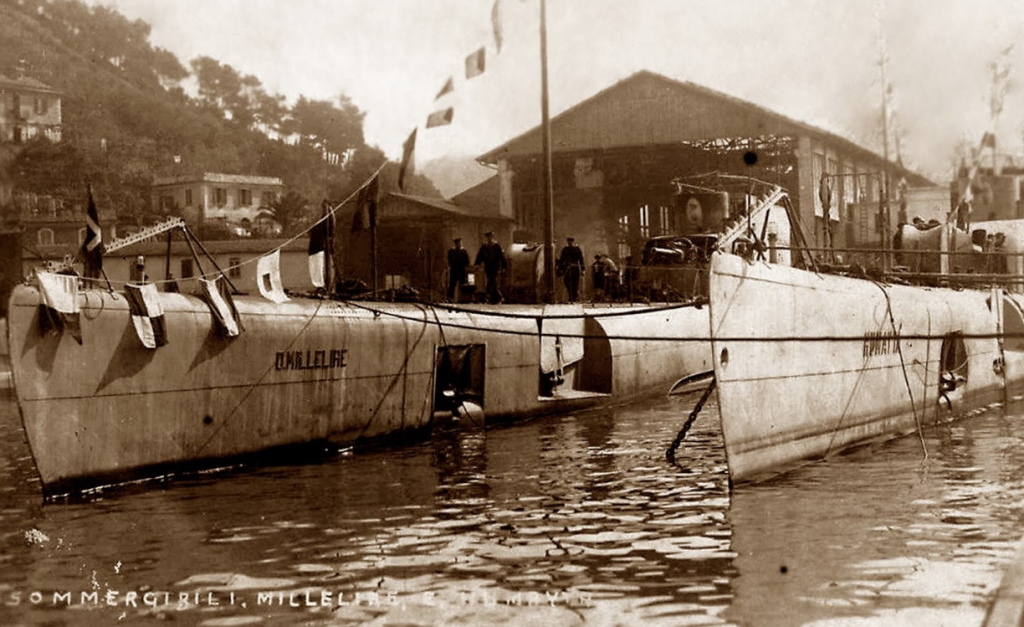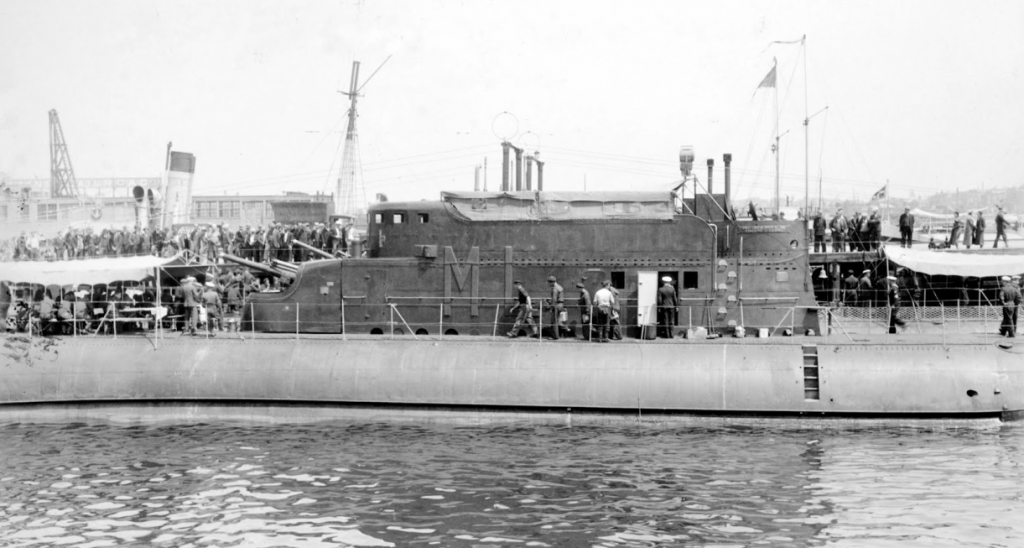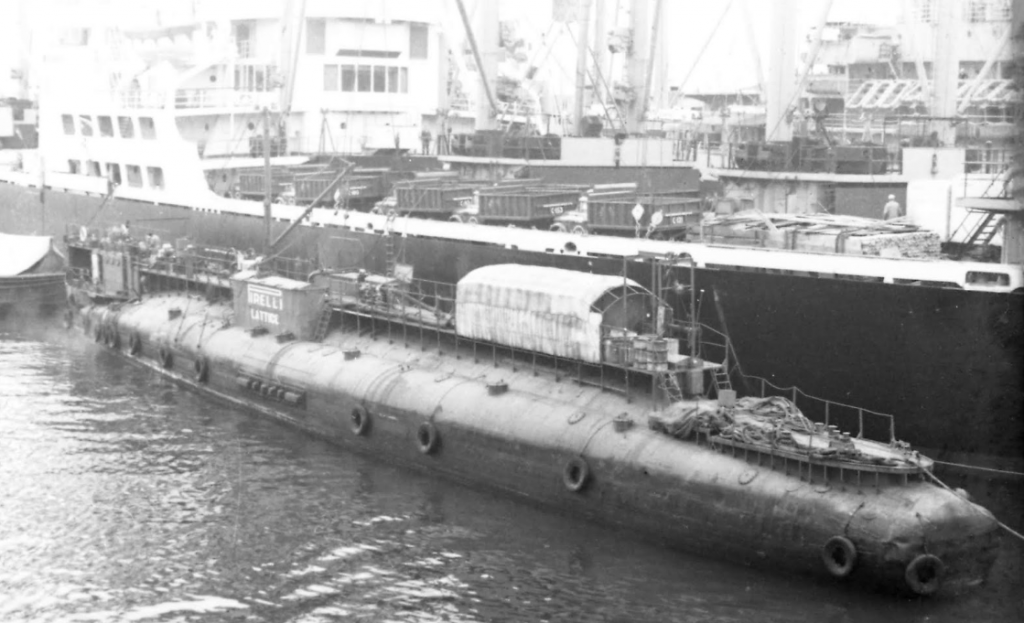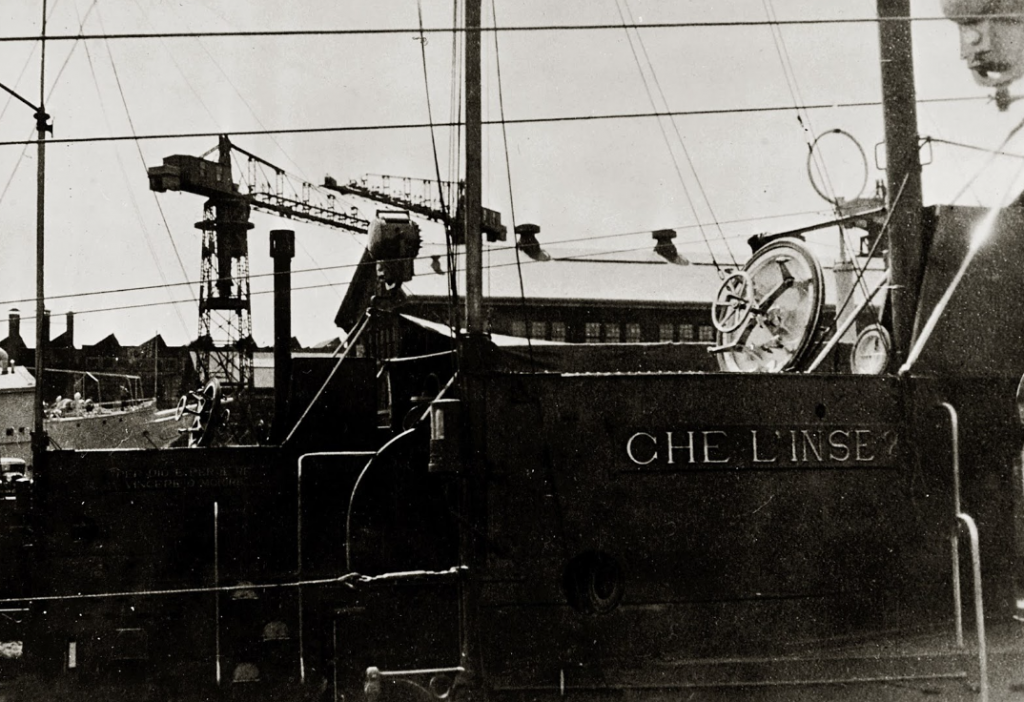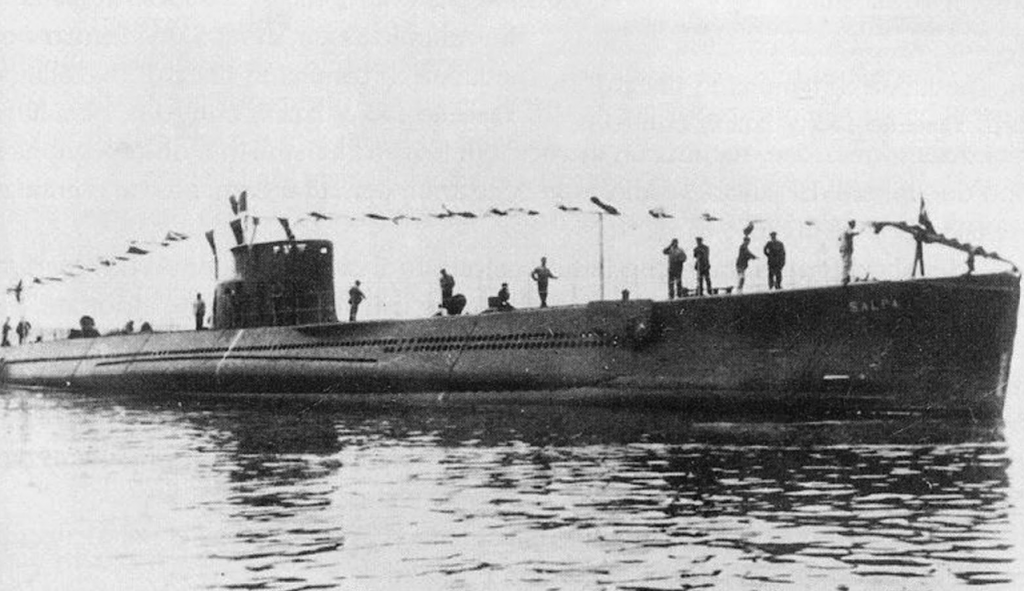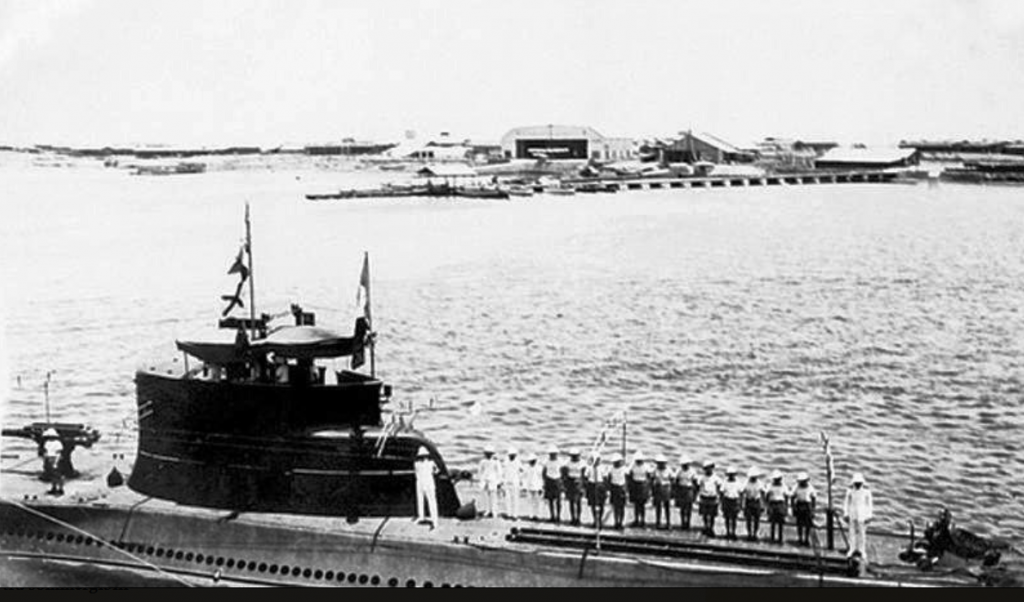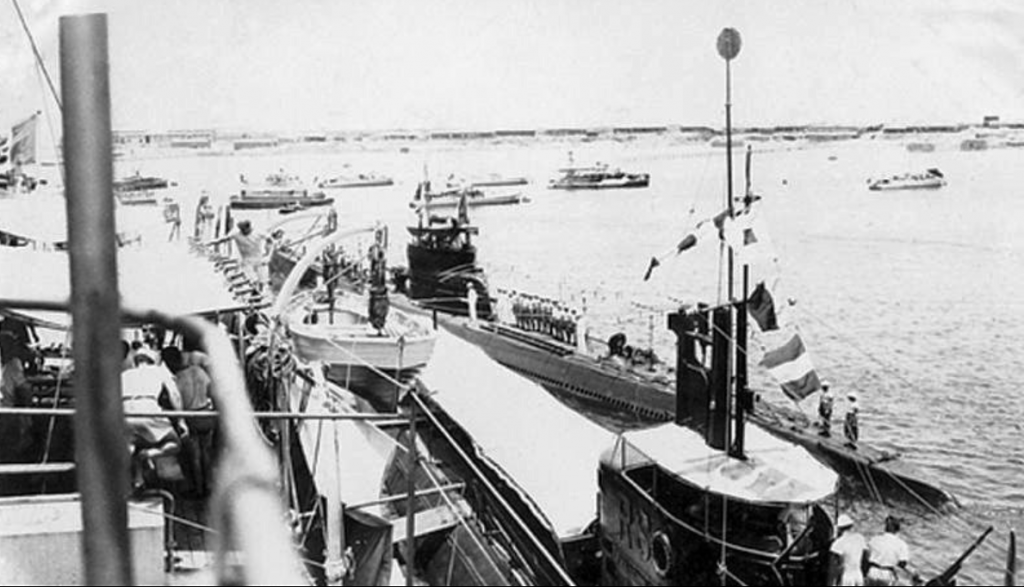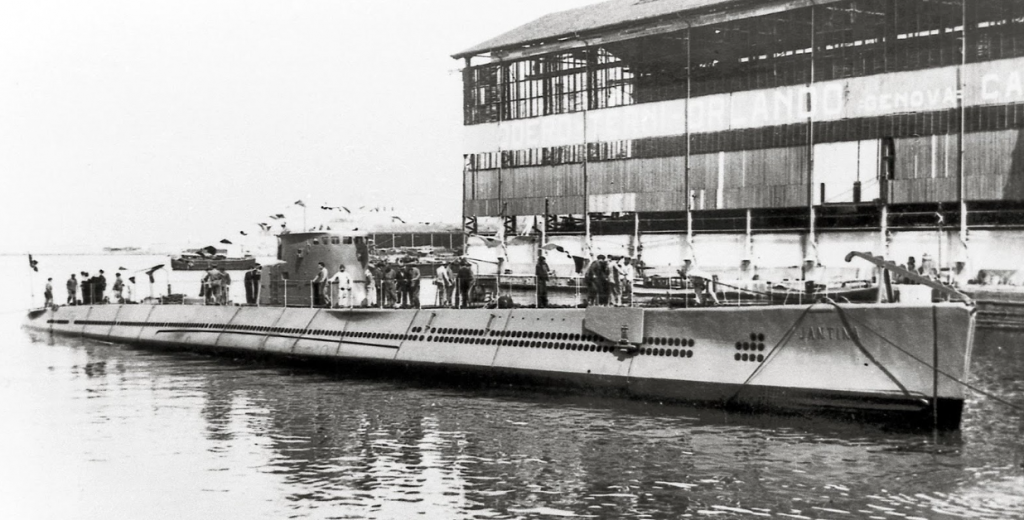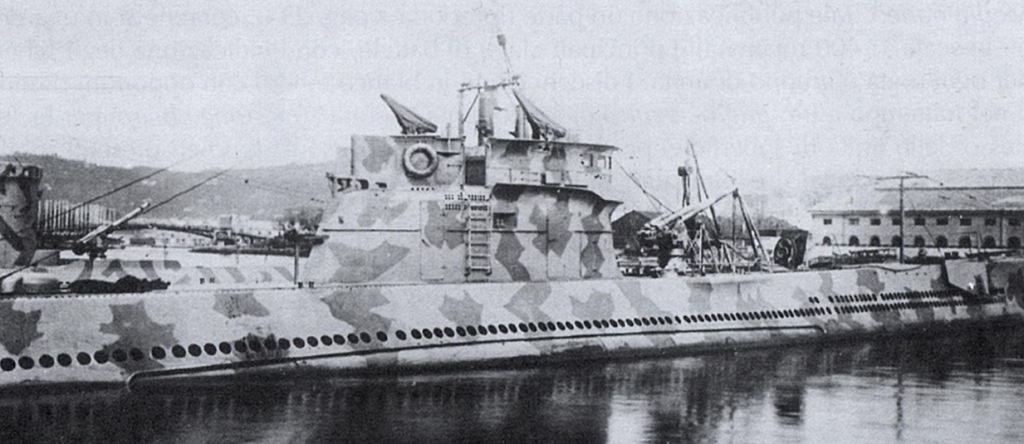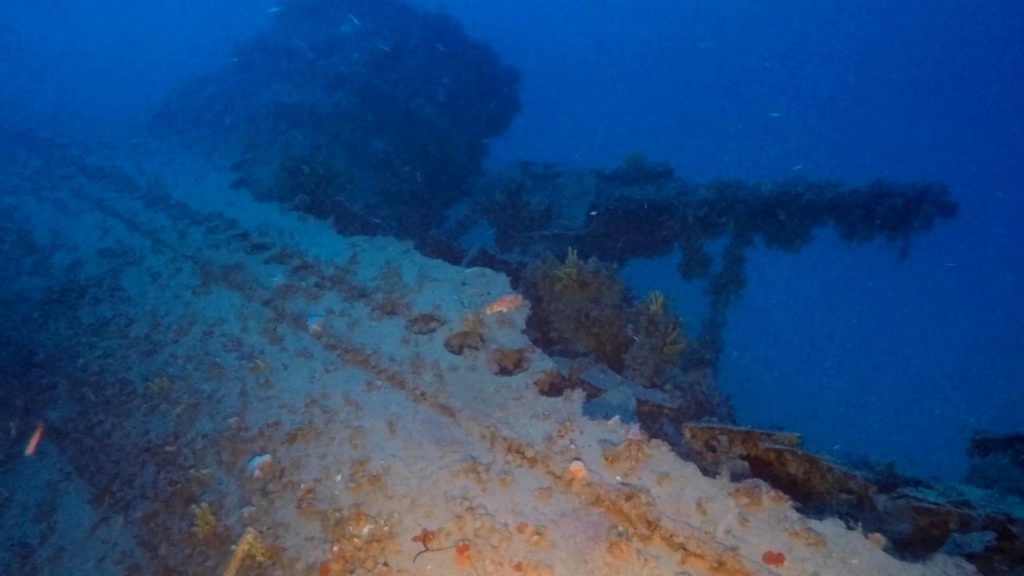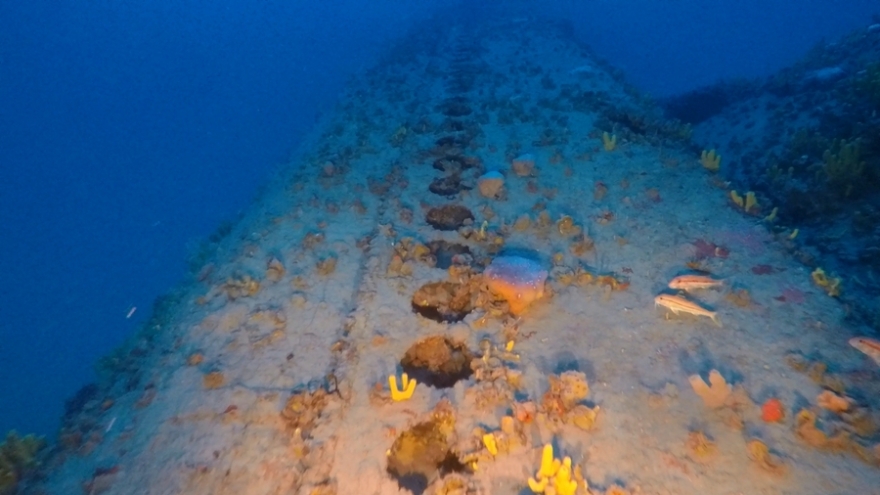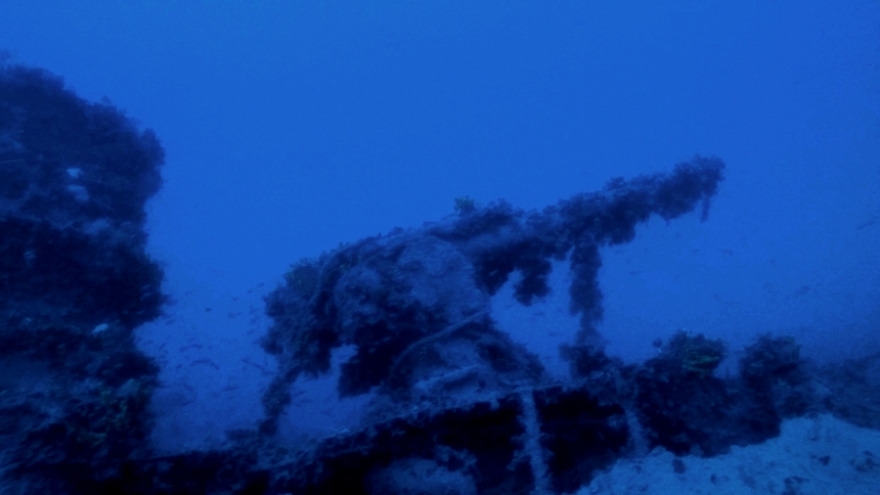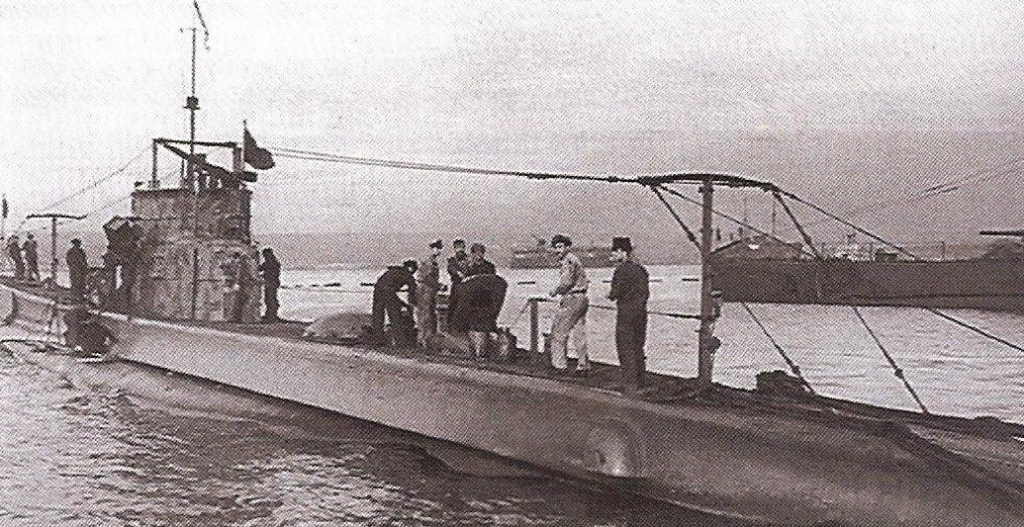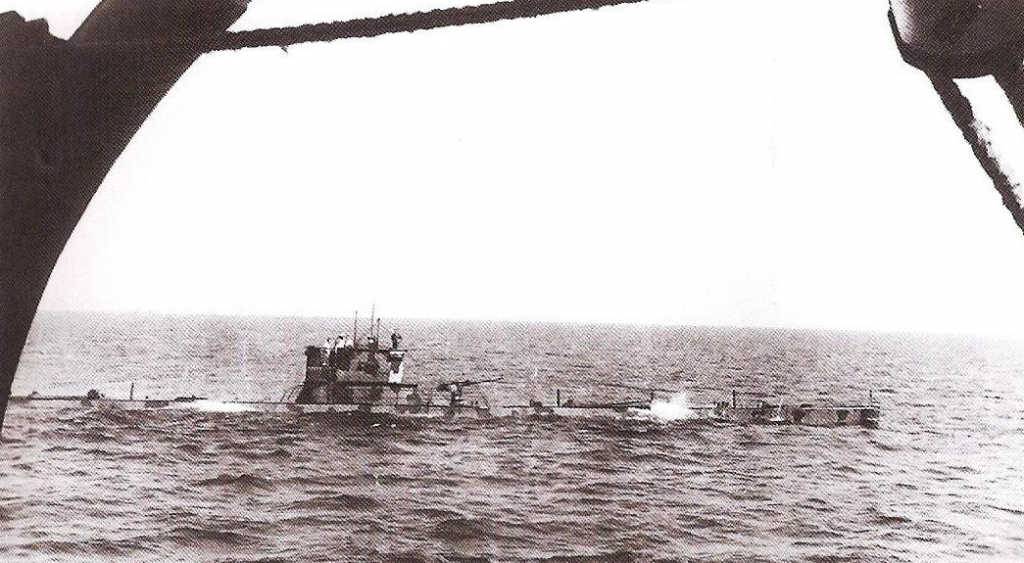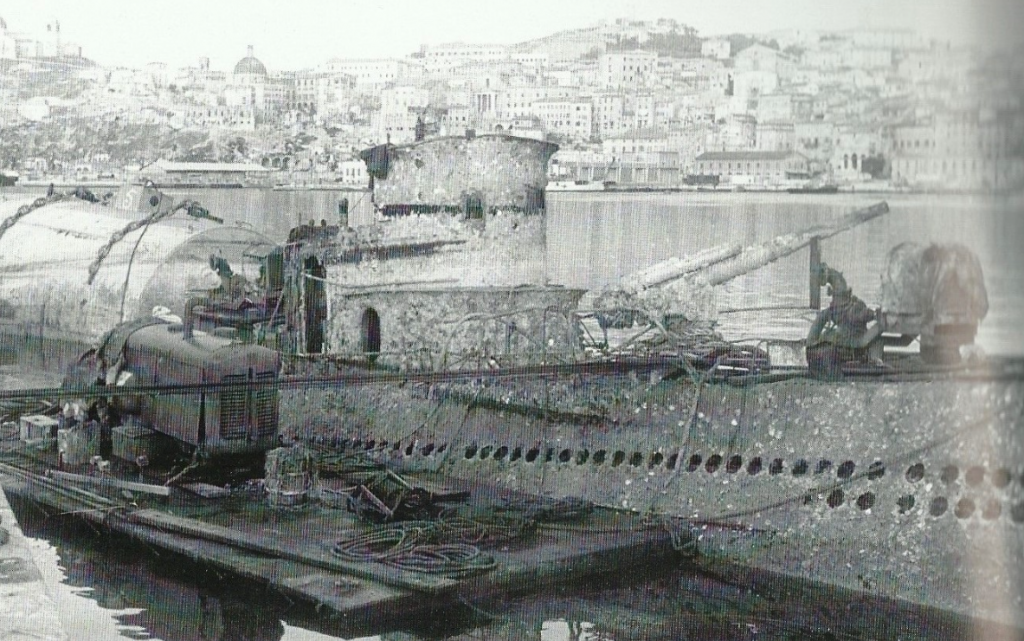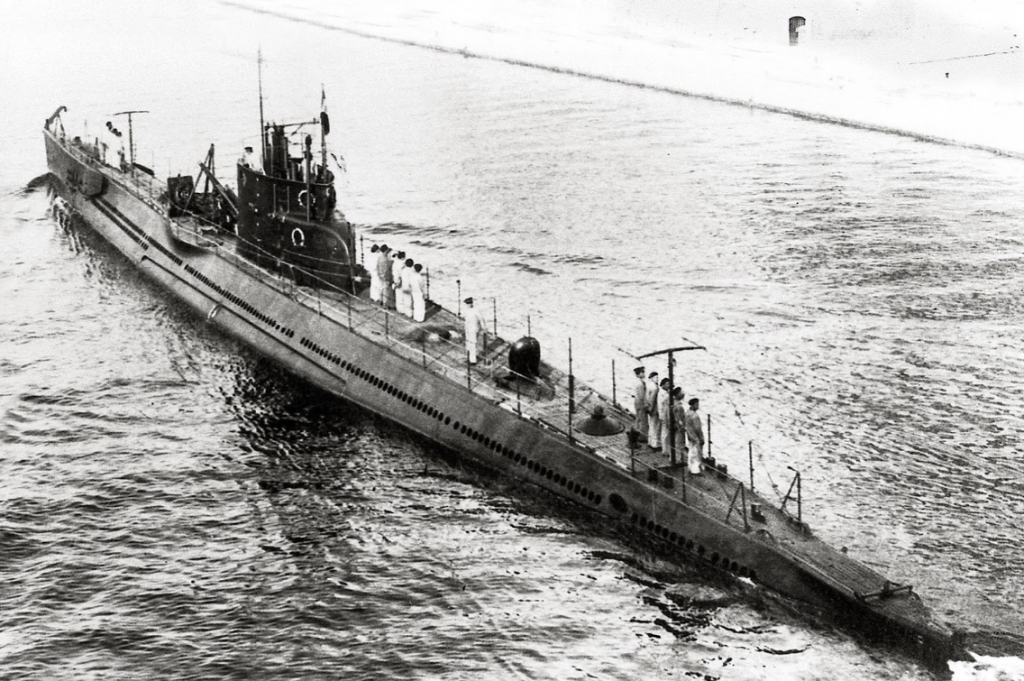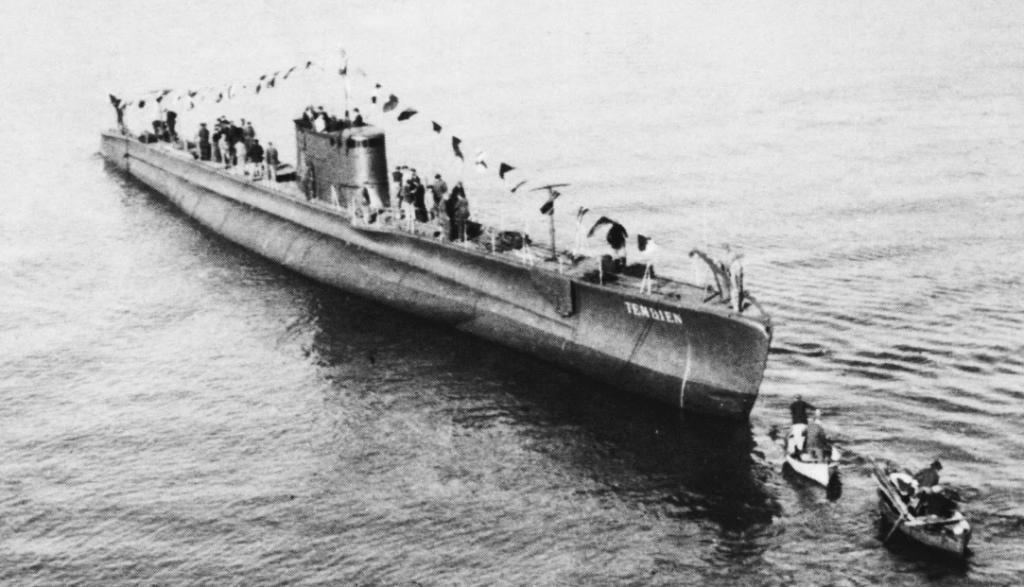Fratelli Bandiera was a medium-range submarine, leader of the class (Bandiera) of the same name. Designed in 1927 by Colonel Curio Bernardis and belonging to the “Bernardis” type with a single hull with resistant central double bottoms and external counter-hulls, the Bandiera were an improved and enlarged version of the previous Pisani class, from which they differed for greater autonomy and speed when submerged, and a greater number of torpedo tubes (eight instead of six).
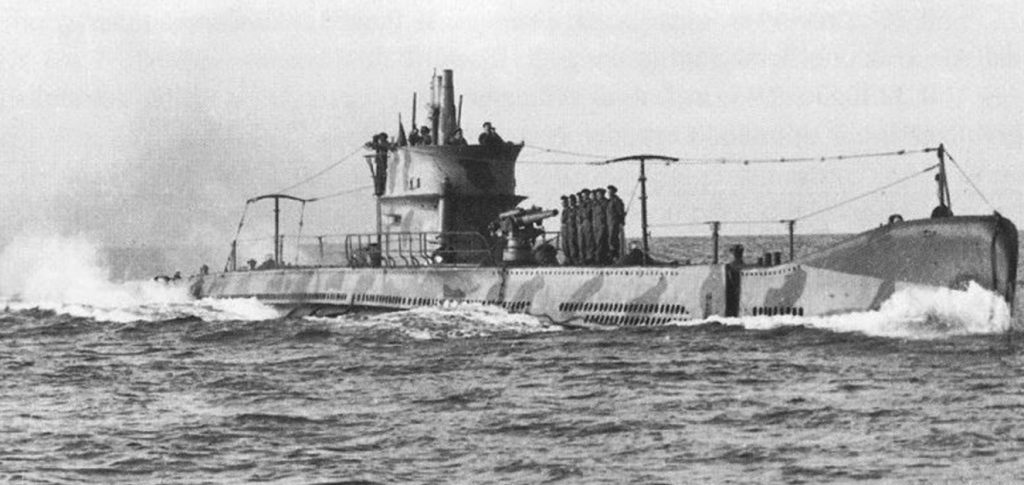
Fratelli Bandiera during the war with the modified cunning tower and painting schema
Brief and Partial Chronology
February 11th, 1928
Set-up started at the Trieste Shipyard in Monfalcone (construction number 187).
August 7th, 1929
Bandiera was launched at the Trieste Shipyard in Monfalcone.

The launch of the submarine Fratelli Bandiera
August 12th (or September 10th), 1930
Entry into active service. Together with the twin boats Luciano Manara, Ciro Menotti and Santorre Santarosa (and for a period, also the minelayer submarine Filippo Corridoni), Bandiera formed the VI Submarine Squadron of medium range, based in Taranto.
1932
The VI Medium Range Submarine Squadron was renamed VII Medium Range Submarine Squadron, also based in Taranto. The Bandiera was visited by P. Yu. Oras, head of the technical-scientific committee of the Soviet Navy. The U.S.S.R.’s navy was interested in the Italian shipbuilding industry, from which in the years that follow, it had several new units designed and built.
1932-1933
The commander of the Bandiera is the Lieutenant Commander Primo Longobardo.

July 1932, Bandiera with the original cunning tower, but with the bow already modified.
(From STORIA militare)
1933
The VII Medium Range Submarine Squadron was transferred to Brindisi, from where it carried out training activities and short cruises in Italian waters. The Bandiera cruised the eastern Mediterranean, calling at various ports in Greece and passing through Tobruk and Tripoli before returning to Italy.
1934
The VII Medium Range Submarine Squadron was renamed VI Medium Range Submarine Squadron, and it was transferred to Naples.
December 23rd, 1934
At 9.15 AM, while Bandiera was leaving the moorings of the port of Monfalcone to move to Pula, there was an explosion in the crankcase of the portside diesel engine, which had just started. The explosion injured twelve men (according to another source, ten) who were in the engine room at the time. The sailors who were on deck at the time of the explosion rushed to the stern hatch and helped the injured personnel getting out, and then, together with the firefighters of the Cantieri Riuniti dell’Adriatico, to extinguish the small fires that the explosion had set in the diesel engine room and in the adjacent ones.
The wounded were taken to the nearby CRDA infirmary, where they received first aid. One of them, the chief mechanic Lorenzo Bettini, died after a quarter of an hour. The others were taken to the civil hospital of Monfalcone. The second chief mechanic Antonio Ruggero, one of the injured, would later recount the incident to the Commission of Inquiry set up by the Navy to investigate the tragic accident: “On the 23rd at 9.15 AM I was in the Diesel Engines room, I was in the corridor intent on monitoring the lubrication of the portside M.T., when I heard a loud bang and I was hit by the flames and a wave of air. The walkway collapsed under me, and I was about to plummet into the bilge when I clung to the circulating oil drainpipes. I groped my way to the stern hatch and as soon as it was clear I came on deck. I was taken to the CRDA infirmary where I received first aid…”
End of 1935
Bandiera was deployed in Tobruk together with the boats of the same class.
1936
Bandiera was transferred to Massawa during the Ethiopian War, under the command of Lieutenant Commander Giuseppe Moschini, to verify the operational capabilities of the class in hot climates.

Bandiera in Massawa
Spring 1938
The boat returned to Italy and was stationed in Messina, where it was part of the XXXII Submarine Squadron (later XXXIV Submarine Squadron) together with Manara, Menotti and Santarosa.
May 5th, 1938
Under the command of the Lieutenant Commander Carlo Liannazza, Bandiera took part, together with the boats of the same class, in the naval magazine “H” organized in the Gulf of Naples for Adolf Hitler’s visit to Italy.
1939
Bandiera underwent a period of maintenance work in Messina. In the same year, the boat was visited in Augusta by Benito Mussolini and the commander-in-chief of the submarine squadron, Admiral Antonio Legnani.

Bandiera in Messina in 1939
(Collection Ennio Bartoli)
June 18th, 1939
Bandiera received the combat flag in Cagliari.
March 22nd, 1940
Lieutenant Renato Maria Pelella, 32, from Torre del Greco, takes command of the Bandiera.
June 1st, 1940
Bandiera made a sortie from Trapani for training from 7.20 AM to noon, having covered 36 miles.
June 10th, 1940
Upon Italy’s entry into the war, Bandiera, together with Manara, Menotti and Santarosa, formed the XXXIII Submarine Squadron, part of the VIII Grupsom, based in Trapani (another source speaks of the III Grupsom of Messina).
June 17th, 1940
Under the command of Lieutenant Renato Maria Pelella, Bandiera left Trapani at 11.55 AM for a patrol in the area bounded by the parallels 37°20′ N and 38°00′ N and the meridians 00°00′ W and 00°40′ W, twenty (or 29) miles west of Cape Palos (Spain). During the mission, the submarine encountered Spanish ships and even an Italian one on several occasions, thus having to abandon the attack maneuvers each time.
June 21st, 1940
In the evening, Bandiera detects the engines of a ship about 7 km away on the hydrophones; At 08:11 PM (according to another source, 07:45 PM) the submarine launched a 533 mm torpedo type W 260 against it from 1,200 meters away, in position 37°03′ N and 00°42′ W (about twenty miles west of Cape Palos). The torpedo misses the target, probably due to rough seas. (Another source claims that this incident took place on June 19th).
July 1st, 1940
Bandiera returned to Trapani at 9.46 AM, after having covered 1,418 miles.
July 8th, 1940
The boat set sail from Trapani at 8.15 AM for training, under the command of Lieutenant Renato Maria Pelella and returned to port at 10.35 AM.
July 11th, 1940
Lieutenant Pelella left command of the Bandiera to Lieutenant Carlo Fecia di Cossato
July 16th, 1940
At 00.15 Bandiera sailed from Trapani under the command of Lieutenant Carlo Fecia di Cossato for a patrol in position 37°55′ N and 09°20′ E. After a few hours, however, he was ordered to return, reaching the base at 6:50 AM after traveling 63.5 miles.
July 16th, 1940
Lieutenant Pietro Prosperini, 38 years old, took command of the Bandiera.
August 2nd, 1940
At 8.16 AM, Bandiera, under the command of Lieutenant Pietro Prosperini, left Trapani for training, returning at 11.20 AM after having covered 21 miles.
August 22nd, 1940
Bandiera left Tapani at 4:05 PM, under the command of Lieutenant Pietro Prosperini, to move to Naples.
August 23rd, 1940
The boat arrived in Naples at 12:18 PM, after having travelled 210 miles.
September 21st through September 27th, 1940
Training sorties from Naples.
September 30rd, 1940
Under the command of Lieutenant Pietro Prosperini, Bandiera left Naples at 18.15 to move to Trapani.
October 1st, 1940
The boat arrived in Trapani at 01.50 PM, after having covered 204 miles.
October 4th, 1940
Training sorties from Trapani.
October 7th, 1940
Bandiera left Trapani at 2.48 PM, under the command of Lieutenant Pietro Prosperini, to move to Messina.
October 8th, 1940
He arrived in Messina at 8.25 AM, after having covered 184 miles.
October 12th, 1940
Under the command of Lieutenant Pietro Prosperini, Bandiera sailed from Messina at 09:00 PM for a patrol south of Crete in the area between the meridians 24°50′ E and 25°40′ E and the parallels 34°10′ N and 34°45′ N.
October 18th, 1940
At 11:40 PM, south of Crete, Bandiera sighted two destroyers engaged in anti-submarine search from 1,200 meters and dove 60 meters to avoid being located. That is what happens. (According to another source, this episode would have taken place on October 21st and Bandiera attempted to attack the destroyers, was detected, and bombarded with depth charges without however suffering damage).
October 25th, 1940
The boat returned to Messina at 8.50 AM, after having covered 1335 miles.
November 8th, 1940
Bandiera sailed from Messina at 05.05 PM, under the command of Lieutenant Pietro Prosperini, for a patrol southeast of Malta, in position 34°45′ N and 15°40′ E. with four other submarines (Topazio, Corallo, Goffredo Mameli, Pier Capponi), to form a barrage about ninety miles south/southeast of Malta to counter the British operation “Coat”.
November 13th, 1940
Bandiera returned to Messina at 4:20 PM, after traveling 696 miles without sighting anything.
November 15th, 1940
The boat sailed from Messina at 23:45 for another patrol southeast of Malta, this time within a radius of twenty miles from 34°20′ N and 16°00′ E.
November 19th, 1940
Recalled by Maricosom, Bandiera returned to Messina at 5.15 PM. During the mission, the crew spotted only one plane, at a great distance. The, it left again at 07:00 PM for another patrol southeast of Malta, in the same area as the previous one.
November 23rd, 1940
The boat returned to Messina at 02.30 PM, after having covered 1,164 miles. During this patrol, the crew spotted only one aircraft.
December 4th, 1940
The boat left Messina, under the command of Lieutenant Pietro Prosperini, from 08.15 AM to 03:00 PM travelling 56 miles.
December 9th, 1940
Bandiera left Messina at 4.40 PM, under the command of Lieutenant Pietro Prosperini, to move to Trapani.
December 10th, 1940
The boat arrived in Trapani at 12.45 PM, after having covered 187 miles.
December 22nd, 1940
Bandiera set sail from Trapani at 8 PM, under the command of Lieutenant Pietro Prosperini, for a patrol in the Strait of Sicily, for a length of twenty miles along an axis oriented to the southeast from point 36°20′ N and 13°00′ E.
December 27th, 1940
The boat r to Trapani at 1:30 PM, after having covered 552 miles.
January 7th, 1941
The boat sailed from Trapani at 6 PM under the command of Lieutenant Pietro Prosperini, for a patrol in the Strait of Sicily along the meridian starting from point 36°25′ N and 12°40′ E.
January 10th, 1941
Between 7:45 and 8:36 AM, Bandiera, lurking thirty miles southeast of Pantelleria, detected on the hydrophones the explosions in the distance of six approaching bombs. The explosions are most likely linked to the passage, not far away, of a British convoy sailing from Gibraltar to Malta and Piraeus as part of the complex operation “Excess”, which involves the simultaneous transit of a total of four convoys.
January 13th, 1941
The boat returned to Trapani at 10:00 AM, after having covered 664 miles.
February 24th, 1941
Still under the command of Lieutenant Prosperini, Bandiera left Trapani at02:00 PM to move to Naples.
February 25th, 1941
The boat arrived in Naples at 01:00 PM, after traveling 206 miles.
February 25th, through April 9th, 1941
Under maintenance in Naples. During this period, Lieutenant Prosperini left the command of the Bandiera, which was provisionally taken over by Sub-Lieutenant Giovanni Manunta (from February 25th to March 25th) and then by Franco Fiaschi (from March 25th to April 9th). At the end of the maintenance work, Lieutenant Carlo Forni, 32, from Genoa, took over command.
April 16th through May 20th, 1941
Once maintenance was completed, Bandiera exited Naples for several training cruises.
May 20th, 1941
Bandiera left for Trapani at 02.15 PM (according to another source 06.30 PM), under the command of Lieutenant Carlo Forni.
May 21st, 1941
The boat arrived in Trapani at 08:00 AM (according to another source, 01.30 PM), after having covered 184 miles (according to another source, 202).
May 28th through June 3rd, 1941
Training cruises.
June 5th, 1941
Bandiera set sail from Trapani at 11.40 PM, under the command of Lieutenant Carlo Forni, for a patrol in position 38°20′ N and 10°00′ E, off Capo Spartivento in Sardinia. The boat was to patrol, together with the submarines Manara and Diaspro, the waters west of Sicily in case British Force H, which has been reported to leave Gibraltar, which escorting a British convoy bound for Malta with supplies where to be detected.
June 12th, 1941
The boat returned to Trapani at 6.40 AM after having covered 1,185 miles without having sighted anything.
June 19th, 1941
At 2.15 PM, Bandiera (Lieutenant Carlo Forni) left Trapani to move to Messina.
June 20th, 1941
The boat arrived in Messina at 08:00 AM, after having covered 184 miles.
June 30th, 1941
The boat left Messina at 2.15 PM, still under the command of Lieutenant Forni, to return to Trapani.
July 1st, 1941
Bandiera arrived in Trapani at 8.20 AM, after having covered 186 miles.
July 4th through July 22nd, 1941
Three sorties from Trapani for short training cruises.
July 22nd, 1941
Bandiera set sail from Trapani at 06.40 PM for a patrol southeast of the Island of Pantelleria, in position 36°40′ N and 12°40′ E, under the command of Lieutenant Carlo Forni. There, it was to form a barrage between Pantelleria and Malta together with her sister boat Luciano Manara and two other submarines, Dessiè and Ruggiero Settimo, to contrast to the British operation “Substance”, consisting of sending to Malta a convoy.
July 23rd, 1941
At 7.20 PM, Bandiera sighted a convoy of six ships (“Substance”) from a distance of 16 km, with a course of 250° and a speed of 14 knots, southeast of Pantelleria. It could not get close enough to attack, so it just sent the discovery signal.
At 9:23 PM, while on the surface, the Bandiera sighted a large ship about 7,000 meters away, but lost contact at 9:50 PM (according to another source, Bandiera sighted first Force H and then the convoy, but failed to get into a favorable position to attack either formation.)
July 24th, 1941
At 7.05 AM, still southeast of Pantelleria, Bandiera sighted a motorboat sailing at 14 knots from 13 km away. Approaching to attack, at 7:45 AM the submarine sighted a destroyer at a distance of 3,000 meters and approached it to attack, but a maneuver of the destroyer thwarted the attempt. Having returned his attention to the motor ship, however, Bandiera was unable to get close enough, and had to give up the attack.
July 27th, 1941
Bandiera arrived in Trapani at 10.40 AM, after having covered 509 miles.
July 31st, 1941
At 03.50 PM, Bandiera (Lieutenant Carlo Forni) sailed from Trapani for a patrol east of Pantelleria, in position 36°40′ N and 12°50′ E, again forming a barrage between Pantelleria and Malta with Manara, Tembien and Zaffiro in contrast to another British operation to supply Malta, “Style”.
August 3rd, 1941
At 3:50 AM, Bandiera received a signal of discovery of a damaged cruiser and headed for the indicated position to attack it but did not sight anything.
August 5th, 1941
The boat returned to Trapani at 08:00 AM, after having covered 584 miles, without having sighted any enemy ships.
August 22nd, 1941
At 08.10 PM, Bandiera (Lieutenant Carlo Forni) sailed from Trapani for a patrol off Ras Mustafà and Kelibia, in an area bounded by the meridian 11°12′ E, the Tunisian coast and the parallels 36°53′ N and 36°57′ N (according to another source, it initially received orders to patrol a sector located south of Pantelleria, and then move off Cape Bon).
August 24th, 1941
Bandiera and the submarines Squalo, Topazio and Tritone form a barrage in the Strait of Sicily together with thirteen MAS, to intercept an alleged British convoy sailing from Gibraltar to Malta, following the sighting of large British naval forces.
August 27th, 1941
At 2:58 AM a silhouette was sighted two and a half miles away, and at 3:15 AM, in position 36°50′ N and 11°07′ E (east of Cape Ras Mustafa), Bandiera launched two torpedoes against it from 1,200 meters away, without success.

M/V Deucalion. On 12 August 1942, five German Heinkel He 111 hit it and it was later scuttled by HMS Bramham.
The target was the British motor ship Deucalion, sailing from Valletta to Gibraltar under the command of Captain Percival John Pycraft. It was one of the merchant ships that arrived in Malta in July as part of operation “Substance”, which were now returning unloaded to Gibraltar sailing alone. The motor ship did not even notice the attack. However, he realized it when at 3.18 AM Bandiera, in pursuit after having launched the signal of discovery, opened fire with the cannon from 3,000 meters away. Deucalion maneuvers at high speed, making it difficult to adjust aiming at the target, and reacted in turn with its cannon. The ship’s shots exploded a few meters from the Bandiera, temporarily blinding the gunners and killing two men, the hydrophone operator sailor Antonio Colucci, 17 years old, from Cirò, and the signal sergeant Giovanni Pinasio, 21 years old, from Piran.
(The register of the fallen and missing of the Navy in the Second World War, however, indicates somewhat different dates and places of death: Colucci in Palestine on August 16th, 1945, and Pinasio in Italy on April 26th, 1944).
For its part, Bandiera managed to hit the mine guard equipment on the left side with a shot. On the British ship it was believed to have been hit by coastal batteries, or to have caused a mine to explode. The brief clash ended at 3.55 AM, in position 36°58′ N and 11°06′ E, as Deucalion managed to outrun the pursuer thanks to its greater speed (according to another source, Commander Forni, believing that he was dealing with a fast and well-armed auxiliary cruiser, decided to break contact and disengage by diving). Bandiera fired a total of twelve shots.
The British destroyer H.M.S. Farndale, which at this juncture had joined forces with Deucalion to take over escort duties, spotted an object in the darkness but did not realize that it was a submarine.
The navigation of the Deucalion to Gibraltar was very eventful: before meeting Bandiera the motor ship has already detonated a mine with the cable of and was fruitlessly shelled by the French coastal batteries of Tunisia, and after the encounter with Bandiera it still run into two MAS (which will not attack it, considering it a French ship) and will also overcome unscathed another attacks by the submarine Squalo and four torpedo bombers – one of which hit the motor ship with a torpedo which did not explode – before arriving in Gibraltar.
September 1st, 1941
At 10.59, Bandiera, sighting a French merchant ship five miles from Ras Mustafa, ordered it to stop by firing a warning shot, then sent on board an inspection squad. It thus emerges that the steamer iwas the Strasbourgeois, of 2,895 GRT, sailing from Casablanca to Sfax with a cargo of barley, of which navigation Bandiera had not been informed in advance. Once it has been established that everything was in order, the French ship was allowed to continue.
September 3rd, 1941
At 9.46 AM, Bandiera sighted off Ras Mustafà another French merchant ship whose presence was not preannounced, the Nantaise, sailing from Port de Bouc to Susa. Once again, the ship was stopped and then allowed to continue after an examination of the documents.
September 5th, 1941
Bandiera returned to Trapani at 3.25 PM, after having covered 1,199 miles.
September 25th, 1941
At 06.26 PM, Bandiera, under the command of Lieutenant Carlo Forni, sailed from Trapani for a patrol off the coast of Algeria and southwest of Sardinia, in an area bounded by the meridians 07°20′ E and 07°40′ E and the parallels 37°50′ N and 38°10′ N. It was to form a barrage north of Cape Ferrat and southwest of Sardinia together with another submarine, Squalo (according to another source also a third, Delfino), to intercept a British naval force that had sailed from Gibraltar as part of Operation “Halberd”, which had begun on September 24th.
September 27th, 1941
At 11:40 PM, a submarine was sighted 1,000 meters away, believed to be Italian, and not wanting to risk, Forni ordered them to leave the area.
September 28th, 1941
At 08:50 PM, Bandiera was ordered to move to 37°20′ N and 07°30′ E, to intercept an enemy ship – again the Deucalion – which was believed – wrongly – to have been damaged by aircraft in that position. Arriving at the indicated spot at midnight, however, Bandiera did not find anything.
September 29th, 1941
At 00.50, in position 37°20′ N and 07°30′ E (for another source, 37°26′ N and 07°14′ E), a submarine resembling the Squalo was sighted; However, Forni decides to leave as a precaution.
At 7:52 AM, two destroyers were sighted 10 km away; one of them, the British H.M.S. Gurkha, in turn sighted the Bandiera and hunted it from 8.16 AM to 11.30 AM, launching 14 depth charges adjusted to explode at depths between 45 and 90 meters. The submarine managed to get away without being damaged.
September 30th, 1941
At 1:05 AM, in position 37°20′ N and 07°30′ E, Bandiera sighted an unknown submarine and moved away to avoid incidents; it was probably Squalo.
October 1st, 1941
Bandiera returned to Trapani at 11.15 PM, after having covered 955 miles.
October 3rd, 1941
Still under the command of Lieutenant Forni, the boat sailed from Trapani at 06.27 PM for a patrol 6 miles south-south-west of Punta Bassana (Marettimo).
October 4th, 1941
At 3:45 AM, eight miles south of Marettimo, Bandiera sighted an enemy submarine, with a course of 160° and a speed of 12 knots, from 2.5 km away. The boat was the British H.M.S. Urge, returning to Malta at the end of a patrol. Bandiera veered portside to approach and attack, but when the distance had dropped to 1000-1200 meters, at 3.55 AM, H.M.S. Urge dove rapidly (in 40 seconds) and contact was lost.
At 6:17 PM, 5.5 miles by 275° from Punta Sottile, a buoy was sighted drifting, detached from a minefield and it was sunk with musket and machine gun fire. Three minutes later, an Italian submarine was sighted, believed to be Ambra or Ametista (it was Ametista). At 8.40 PM, Bandiera returned to Trapani, after having covered 140 miles.
October 7th, 1941
At 8.40 AM, while Bandiera was moored in Trapani near the submarines Squalo and Narvalo, a shot was accidentally fired from Squalo’s cannon: the accident caused one wounded on Bandiera – a sailor – one on the Squalo, and one dead and two wounded on the Narvalo.
October 10th, 1941
Bandiera set sail from Trapani at 6.15 PM, still under the command of Lieutenant Forni, for a patrol between the meridians 10°00′ E and 10°20′ E and the parallels 37°20′ N and 37°40′ N, east of the Galite.
October 16th, 1941
Bandiera and the submarine Aradam were ordered to form a barrage between the Galite and Cape Bougaroni following the departure from Gibraltar of Force. A total of 11 submarines are deployed in the Strait of Sicily to form a barrage: Bandiera, Ambra, Ametista, Corallo, Diaspro, Alagi, Squalo, Serpente, Turchese, Narvalo, and Delfino.
October 18, 1941
October 20th, 1941
Bandiera returned to Trapani at 11.36.
November 11th, 1941
At 9.25 PM, Bandiera, under the command of Lieutenant Forni, sailed from Trapani to patrol the “K.2” area, between the meridians 36°53′ N and 36°57′ N, the parallel 11°12′ E and the Tunisian coast.
November 17th, 1941
The boat was ordered to move to the west of Malta, in an area bounded by the meridians 13°10′ E and 13°40′ E and the parallels 35°00′ N and 35°40′ N.
November 19th, 1941
Bandiera returned to Trapani at 7:50 PM, at the end of an uneventful mission, in which the boat covered 1,097 miles.
November 26th, 1941
The boat left Trapani at 2.15 PM, still under the command of Lieutenant Forni, to move to Naples.
November 27th, 1941
Bandiera arrived in Naples at noon, after having covered 186 miles. There, it began a period of maintenance work.
December 8th, 1941
Lieutenant Forni handed over command to Amedeo Stinchi, 30, from Naples.
December 29th, 1941
Lieutenant Stinchi was replaced by Massimiliano Iasiello, 30, from Ancona.
February 3rd, 1942
Lieutenant Iasiello left command of Bandiera, replaced by Libero Sauro, 37, from Koper.
March 5th, 1942
Once work was completed, Bandiera set sail from Naples for a training trip at 9.20 AM, under the command of Lieutenant Libero Sauro, returning to port at 1.10 PM, after having covered 28 miles.
March 10th through March 11th, 1942
Training cruises from Naples.
March 15th, 1942
Lieutenant Sauro handed over the command of Bandiera to Mario Vannutelli, 35, from Apuania.
March 17th through April 3rd, 1942
Training cruises.
April 3rd, 1942
At 9:15 PM, the Bandiera, still under the command of Lieutenant Vannutelli, left Naples to move to Pula, where it took up service at the Submarine School, to which it had been assigned as a training unit in consideration of its wear and tear, along with the submarines Manara and Menotti.
April 4th, 1942
Cruise across the Strait of Messina, escorted by the small auxiliary escort ship Lago Tana.
April 6th, 1942
At 10.20 AM he sighted a drifting mine in position 41°37′ N and 17°15′ E, sinking it with machine gun fire.
April 7th, 1942
Bandiera arrived in Pula at 9:25 AM, after having travelled 926 miles.
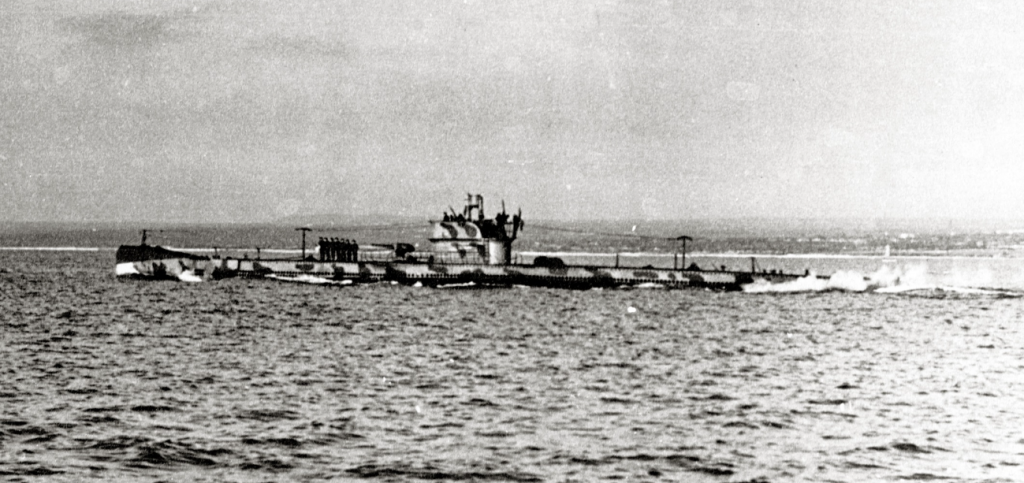
Bandiera in Pula with the new mimetic painting schema
(Naval History and Heritage Command)
April 12th, 1942
The boat set sail from Pula at 6.28 AM, under the command of Lieutenant Mario Vannutelli, for an exercise together with the auxiliary escort ship F 95 San Giorgio. The submarine Vettor Pisani, which left Fiume, also joined the exercise; at the end of the exercise, Bandiera also headed towards Rijeka, where it arrived at 11.51 after having covered 58 miles.
April 15, through June 30th, 1942
Training cruises from Rijeka
July 1st, 1942
Still under the command of Lieutenant Mario Vannutelli, Bandiera left Rijeka at 6.10 AM to move to Pula, where it arrived at 12.03 PM, after having covered 58 miles.
July 2nd through August 18th,1942
Training cruises from PUla
August 20, 1942
At 02.05 AM Bandiera left Pula under the command of Lieutenant Vannutelli to move to Venice, at the same time carrying out a defensive hydrophone patrol.
August 21st, 1942
The boat arrived in Venice at 09:00 AM, after having travelled 82.8 miles.
August 22nd, 1942
The boat left Venice at 11:00 PM and returned to Pula.
August 23rd, 1942
Bandiera arrived in Pula at 07:00 AM, after having travelled 73.5 miles.
August 27th, 1942, through August 30th, 1943
Assigned to the Pula submarine school where the boat completed many training cruises from Pula and Rijeka.
August 30th, 1943
At 1.47 AM the Bandiera, under the command of Lieutenant Commander Rodolfo Scarelli, sailed from Susak to Brindisi. At 8:50 AM, a German plane was sighted, with which recognition signals were exchanged.
September 1st, 1943
Bandiera reached Brindisi at 6.40 AM, after having covered 453 miles.
September 7th, 1943
Under the command of Lieutenant Commander Rodolfo Scarelli, Bandiera sailed from Brindisi at 06.19 PM to reach an ambush sector in the Ionian Sea. Maricosom (the Submarine Squadron Command), having received news of the sighting of the Anglo-American invasion fleet heading towards the coasts of southern Italy, gave the go-ahead for the “Zeta” Plan for the protection of the coasts of Southern Italy.
As part of the “Zeta” Plan, the Bandiera was sent to form a barrage in the Ionian Sea (between the eastern coasts of Sicily and Calabria and Cape Santa Maria di Leuca in Puglia) together with seven other submarines (Squalo, Marcantonio Bragadin, Jalea, Zoea, Luigi Settembrini, Onice and Vortice.
September 8th, 1943
The announcement of the armistice between Italy and the Allies surprises Bandiera in the Ionian Sea.
At 7:50 PM, eight minutes after the EIAR announced the news to the nation (the Allies announced it at 6:30 PM, via Radio Algiers), Maricosom issued the message to all submarines at sea: “On receipt of this order, assume a task exclusively I repeat exclusively exploratory,” followed at 9:10 PM by “Upon receipt of this message, cease all hostilities to the accused received.” At 9:50 PM, Maricosom ordered all submarines: “Dive immediately to a depth of 80 meters alt At 08:00 AM on the 9th, emerge remaining on the surface flying the national flag and a black ribbon at the bow periscope STOP You will receive further orders alt Accuse received.”
Commander Scarelli of Bandiera decides to consult with the commanders of Squalo (Lieutenant Carlo Girola) and Bragadin (Lieutenant Alpinolo Cinti), lurking in contiguous areas: while Girola and Cinti decide to reach Augusta, a Sicilian port under British control, Scarelli sets course for Taranto.
September 11th, 1943
Damaged by bombers attack, Bandiera reached Taranto at 08.40 PM, after having covered 704 miles.
September 12th, 1943
The boat left Taranto at 9.40 AM, under the command of Lieutenant Aredio Galzigna, together with the submarines Atropo and Jalea to move to Malta, as per armistice provisions. The group was accompanied by the destroyer Augusto Riboty and the British destroyer H.M.S. Troubridge.
September 13th, 1943
Bandiera arrived in Malta at 08:40 PM(after having covered 331 miles), along with Atropos, Gialea and Riboty. The four vessels, together with the torpedo boats Libra and Orione, the seaplane carrier Giuseppe Miraglia and the submarine Ciro Menotti, went to moor in St. Paul’s Bay.
September 19th, 1943
Lieutenant Galzigna was replaced in command of Bandiera by Lieutenant Giuseppe Ridella, 24, from Ferrara.
September 21st, 1943
The Italian submarines in Malta, previously scattered in the various moorings of the island, were grouped into two groups, one concentrated in Marsa Scirocco and the other in São Paulo.
Bandiera was temporarily stationed in the mooring of Marsa Scirocco, together with nine other submarines (Atropo, Axum, Bragadin, Corridoni, Giada, Marea, Nichelio, Settembrini, Vortice; from 6 October also Turchese), under the “dependence” of the battleship Giulio Cesare.
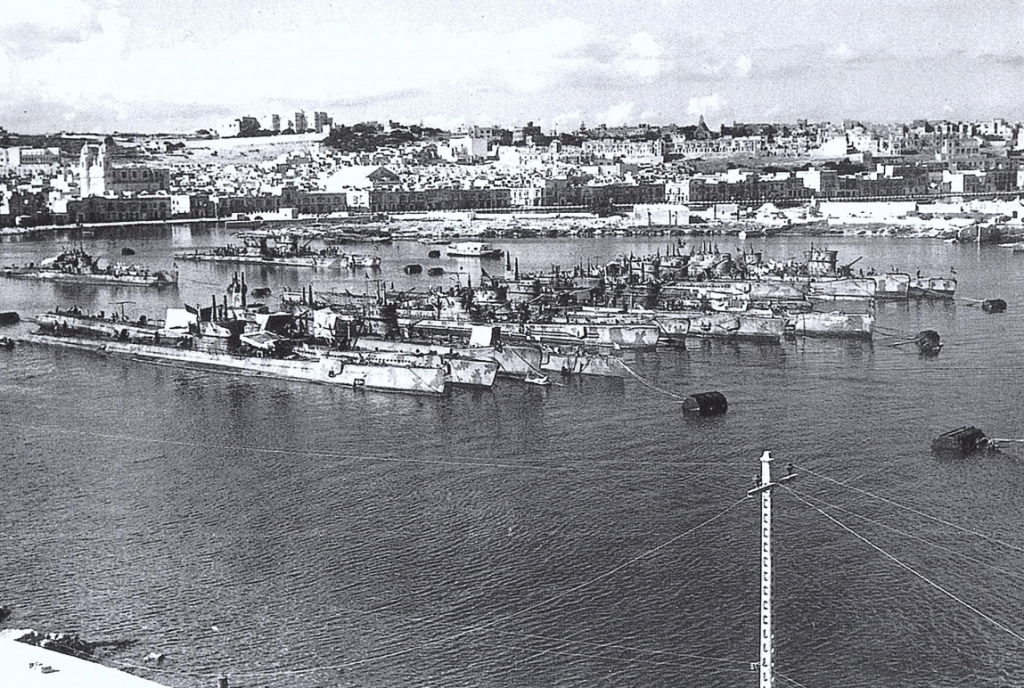
Bandiera in Malta. The boat is the third one from the left.
(From STORIA militare)
November 19th, 1943
Under the command of Lieutenant Giuseppe Ridella, Bandiera left Malta at 04.15 PM to return to Italy, together with the submarines Brin, Squalo and Settembrini and with the escort of the corvette Chimera.
November 20th, 1943
Bandiera arrived in Augusta at 11:00 AM, after having covered 125 miles.
November 21st, 1943
Lieutenant Ridella was replaced in command of Bandiera by Ugo Esmenard, 25, from Bologna.
November 23rd, 1943
Under the command of Lieutenant Ugo Esmenard, Bandiera left Augusta at 6.40 AM, together with the Squalo and the British destroyer H.M.S. Paladin, to move to Naples.
November 24, 1943
The boat arrived in Naples at 12:35 PM, after traveling 253.8 miles. There, it entered the shipyard for a long period of work, during which the commander as changed several times; On December 17th, 1943 Lieutenant Commander Marco Revedin, 32 years old, from Bologna, took command, who was then replaced on April 20th, 1944 by Lieutenant Carlo Girola, 29 years old, from La Spezia.
April 29th through July 21st, 1944
Small cruises for sea trial.
July 30, 1944
Bandiera left Naples at 05:34 PM, together with the torpedo boat Nicola Fabrizi, to move to Augusta.
July 31st, 1944
The boat arrived in Augusta at 6:58 PM, having covered 245.2 miles.
August 4th, 1944
Bandiera left Augusta at 09:00 AM, under the command of Lieutenant Carlo Girola, to move to Taranto, together with the corvette Cormorano.
August 5th, 1944
The boat arrived in Taranto at 4:28 PM, after having covered 262 miles.
August 7th, 1944, through October 21st, 1944
Several small patrols off Taranto for training.
October 29th, 1944
Bandiera left Taranto at 7.23 AM, under the command of Lieutenant Carlo Girola, to move to Augusta, together with the Jalea and the torpedo boat Animoso.
October 30th, 1944
The boat arrived in Augusta at 12:53 PM, having covered 248 miles.
November 3rd, 1944
Under the command of Lieutenant Carlo Girola, the Bandiera left Augusta at 6.30 AM, together with the Jalea and the British armed fishing boat Stroma, to move to Malta.
November 4th, 1944
The boat arrived in Malta at 2.55 PM, having covered 214.2 miles.
November 7th, 1944
Bandiera (Lieutenant Carlo Girola) and Jalea left Malta at 6.08 AM to move to Port Said, but Bandiera suffered a breakdown that forced it to return to Malta, where it moored at 01.48 PM, after having covered 59.5 miles.
November 9th, 1944, through November 12, 1944
Sea trial following repairs.
November 13th, 1944
Under the command of Lieutenant Carlo Girola, the Bandiera left Malta at 5.55 AM to move to Alexandria, Egypt.
November 17th, 1944
The boat arrived in Alexandria at 10:35 AM, having traveled 892 miles.
December 2nd, 1944
Still under the command of Lieutenant Carlo Girola, the Bandiera left Alexandria at 16:43 bound for Haifa (British Palestine), together with the submarine Zoea.
December 4th, 1944
Bandiera arrived in Haifa at 6:34 AM, after traveling 312 miles, passing under the command of the Levant Submarine Group Command. This group was established in October 1943 under the command of Lieutenant Commander Carlo Liannazza (who is also commander of the Italian Higher Naval Command of the Levant, Maricosulev Haifa). The submarines, attached to the Royal Navy’s 1st Submarine Flotilla, were used to train British corvettes in the Alexandria area.
December 12nd, 1944 Through September 23rd, 1945
Training patrols from Haifa and Alexandria.
October 6th, 1945
Bandiera left Alessandria at 6:06 AM, under the command of Lieutenant Eugenio Parodi, to finally return to Italy.
October 10th, 1945
The boat arrived in Brindisi at 01:15 PM, after having covered 859 miles. It was then laid up in decommissioning.
February 1st, 1948
Removed from the list of active ships and later demolished.
Operational Records
| Type | Patrols (Med.) | Patrols (Other) | NM Surface | NM Sub. | Days at Sea | NM/Day | Average Speed |
|---|---|---|---|---|---|---|---|
| Submarine – Medium Range | 39 | 15976 | 1899 | 131 | 136.45 | 5.69 |
Actions
| Date | Time | Captain | Area | Coordinates | Convoy | Weapon | Result | Ship | Type | Tonns | Flag |
|---|---|---|---|---|---|---|---|---|---|---|---|
| 08/27/1941 | 02:58 | C.C. Carlo Forni | Mediterranean | 36°50’N-11°07’E | Torpedo | Failed | Deucalion | Motor Freighter | 7740 | Great Britain |
Crew Members Lost
| Last Name | First Name | Rank | Italian Rank | Date |
|---|---|---|---|---|
| Colucci | Antonio | Sergeant | Sergente | 8/27/1941 |
| Pinasio | Giovanni | Naval Rating | Comune | 8/27/1941 |
